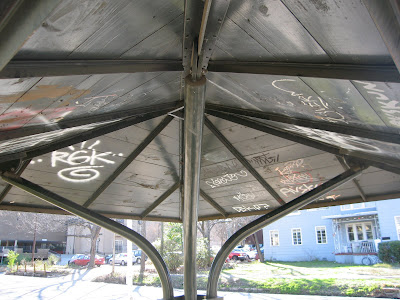 On a bright sunny afternoon at 21st & Rio Grande, the student comes across the bus stop. A common 'urban intervention' with its pyramidical canopy - meant to perhaps resemble the rooftops of the mundane suburban houses - is a typical unit of the city-wide mass transit system. The typical user is the everyday passenger awaiting the next bus to take him/her to the next destination. The designer has therefore successfully created a shaded urban space for the public using the mass transit system. All is well until...
On a bright sunny afternoon at 21st & Rio Grande, the student comes across the bus stop. A common 'urban intervention' with its pyramidical canopy - meant to perhaps resemble the rooftops of the mundane suburban houses - is a typical unit of the city-wide mass transit system. The typical user is the everyday passenger awaiting the next bus to take him/her to the next destination. The designer has therefore successfully created a shaded urban space for the public using the mass transit system. All is well until...The student discovers a set of spray painted tags under the canopy.
 On a closer look, the canopy reveals a plethora of random etchings, tagged initials, profanities and politically charged statements. The canopy has instantly transformed from a structure that provides shade to the waiting passenger to a canvas for the odd vandal/artist/egoist/activist. The user is no longer passive. In fact, the user is no longer easily defined.
On a closer look, the canopy reveals a plethora of random etchings, tagged initials, profanities and politically charged statements. The canopy has instantly transformed from a structure that provides shade to the waiting passenger to a canvas for the odd vandal/artist/egoist/activist. The user is no longer passive. In fact, the user is no longer easily defined.
These revelations open up the student's imagination to the possibilities. Refuge on a rainy day, lodging for the homeless, hub of a social moment (temporary but always regenerating), a billboard for the frustrated, the talented. It would seem some aspects of the bus stop's 'versatility' and 'personality' are something the designer never intended. Surely, he/she never thought the bus schedule would be questioned so blatantly.

The monotony of the designer's standardized canopy is clearly being subverted by this different 'set' of users. The billboard, as seen by the student, also showed up at a similar canopy at 12th & Rio Grande.

Clearly, the categories are misleading. Given the ingenuity and adaptability of the user, the constant defacing and decorating of the structure, the urban intervention - much like the urban environment it is set in - is always in flux. In such a situation, the intervention evolves long after the design is finalized, the public is not a fixed category and the user is far less predictable but perhaps more interesting.
The student lets his mind wander and question...
"Given this situation, what is the role of the designer? Given this situation, whom is the designer designing for? And more importantly, given the ambiguities in defining the user itself, let alone understanding its various needs, HOW is the designer to design?"
This is going to be an interesting semester...
-- Sourav Biswas
No comments:
Post a Comment